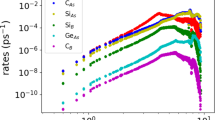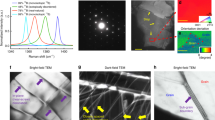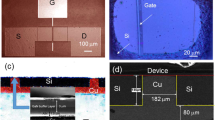Abstract
Thermal management is critical in modern electronic systems. Efforts to improve heat dissipation have led to the exploration of novel semiconductor materials with high thermal conductivity, including boron arsenide (BAs) and boron phosphide (BP). However, the integration of such materials into devices and the measurement of their interface energy transport remain unexplored. Here, we show that BAs and BP cooling substrates can be heterogeneously integrated with metals, a wide-bandgap semiconductor (gallium nitride, GaN) and high-electron-mobility transistor devices. GaN-on-BAs structures exhibit a high thermal boundary conductance of 250 MW m−2 K−1, and comparison of device-level hot-spot temperatures with length-dependent scaling (from 100 μm to 100 nm) shows that the power cooling performance of BAs exceeds that of reported diamond devices. Furthermore, operating AlGaN/GaN high-electron-mobility transistors with BAs cooling substrates exhibit substantially lower hot-spot temperatures than diamond and silicon carbide at the same transistor power density, illustrating their potential for use in the thermal management of radiofrequency electronics. We attribute the high thermal management performance of BAs and BP to their unique phonon band structures and interface matching.
This is a preview of subscription content, access via your institution
Access options
Access Nature and 54 other Nature Portfolio journals
Get Nature+, our best-value online-access subscription
$29.99 / 30 days
cancel any time
Subscribe to this journal
Receive 12 digital issues and online access to articles
$119.00 per year
only $9.92 per issue
Buy this article
- Purchase on Springer Link
- Instant access to full article PDF
Prices may be subject to local taxes which are calculated during checkout




Similar content being viewed by others
Data availability
The data that support the plots within this paper and the other findings of this study are available from the corresponding author upon reasonable request.
References
Waldrop, M. M. The chips are down for Moore’s law. Nature 530, 144–147 (2016).
Ball, P. Computer engineering: feeling the heat. Nature 492, 174–176 (2012).
ITRS. International Technology Roadmap for Semiconductors 2.0: Executive Report 79 (Semiconductor Industry Association, 2015).
Cui, Y., Li, M. & Hu, Y. Emerging interface materials for electronics thermal management: experiments, modeling and new opportunities. J. Mater. Chem. C 8, 10568 (2020).
Bubnova, O. Thermal release. Nat. Nanotechnol. 13, 620 (2018).
Cui, Y., Qin, Z., Wu, H., Li, M. & Hu, Y. Flexible thermal interface based on self-assembled boron arsenide for high-performance thermal management. Nat. Commun. 12, 1284 (2021).
Kang, J. S., Wu, H. & Hu, Y. Thermal properties and phonon spectral characterization of synthetic boron phosphide for high thermal conductivity applications. Nano Lett. 17, 7507–7514 (2017).
Kang, J. S., Li, M., Wu, H., Nguyen, H. & Hu, Y. Experimental observation of high thermal conductivity in boron arsenide. Science 578, 575–578 (2018).
Li, S. et al. High thermal conductivity in cubic boron arsenide crystals. Science 581, 579–581 (2018).
Tian, F. et al. Unusual high thermal conductivity in boron arsenide bulk crystals. Science 585, 582–585 (2018).
Kang, J. S., Li, M., Wu, H., Nguyen, H. & Hu, Y. Basic physical properties of cubic boron arsenide. Appl. Phys. Lett. 115, 122103 (2019).
Lindsay, L., Broido, D. A. & Reinecke, T. L. First-principles determination of ultrahigh thermal conductivity of boron arsenide: a competitor for diamond? Phys. Rev. Lett. 111, 025901 (2013).
Broido, D. A., Lindsay, L. & Reinecke, T. L. Ab initio study of the unusual thermal transport properties of boron arsenide and related materials. Phys. Rev. B 88, 214303 (2013).
Wu, H., Fan, H. & Hu, Y. Ab initio determination of ultrahigh thermal conductivity in ternary compounds. Phys. Rev. B 103, L041203 (2021).
Fan, H., Wu, H., Lindsay, L. & Hu, Y. Ab initio investigation of single-layer high thermal conductivity boron compounds. Phys. Rev. B 100, 085420 (2019).
Feng, T., Lindsay, L. & Ruan, X. Four-phonon scattering significantly reduces intrinsic thermal conductivity of solids. Phys. Rev. B 96, 161201(R) (2017).
Mingo, N. & Broido, D. A. Lattice thermal conductivity crossovers in semiconductor nanowires. Phys. Rev. Lett. 93, 246106 (2004).
Ward, A., Broido, D. A., Stewart, D. A. & Deinzer, G. Ab initio theory of the lattice thermal conductivity in diamond. Phys. Rev. B 80, 125203 (2009).
Esfarjani, K., Chen, G. & Stokes, H. T. Heat transport in silicon from first-principles calculations. Phys. Rev. B 84, 085204 (2011).
Hu, Y., Zeng, L., Minnich, A. J., Dresselhaus, M. S. & Chen, G. Spectral mapping of thermal conductivity through nanoscale ballistic transport. Nat. Nanotechnol. 10, 701–706 (2015).
Ziman, J. M. Electrons and Phonons: The Theory of Transport Phenomena in Solids (Oxford Univ. Press, 1960).
Swartz, E. T. & Pohl, R. O. Thermal boundary resistance. Rev. Mod. Phys. 61, 605–668 (1989).
Li, M., Kang, J. S. & Hu, Y. Anisotropic thermal boundary resistance across two-dimensional black phosphorous: experiment and atomistic modeling of interfacial energy transport. Adv. Mater. 31, 1901021 (2019).
Kittel, C. Introduction to Solid State Physics (Wiley, 1976).
Cho, J. et al. Improved thermal interfaces of GaN–diamond composite substrates for HEMT applications. IEEE Trans. Compon. Packag. Manuf. Technol. 3, 79–85 (2013).
Pomeroy, J. W., Bernardoni, M., Dumka, D. C., Fanning, D. M. & Kuball, M. Low thermal resistance GaN-on-diamond transistors characterized by three-dimensional Raman thermography mapping. Appl. Phys. Lett. 104, 083513 (2014).
Liu, D. et al. GaN-on-diamond electronic device reliability: mechanical and thermo-mechanical integrity. Appl. Phys. Lett. 107, 251902 (2015).
Li, M., Kang, J. S. & Hu, Y. Anisotropic thermal conductivity measurement using a new asymmetric-beam time-domain thermoreflectance (AB-TDTR) method. Rev. Sci. Instrum. 89, 084901 (2018).
Kang, J. S., Wu, H., Li, M. & Hu, Y. Intrinsic low thermal conductivity and phonon renormalization due to strong anharmonicity of single-crystal tin selenide. Nano Lett. 19, 4941–4948 (2019).
Stoner, R. J., Maris, H. J., Anthony, T. R. & Banholzer, W. F. Measurements of the Kapitza conductance between diamond and several metals. Phys. Rev. Lett. 68, 1563–1566 (1992).
Monachon, C., Weber, L. & Dames, C. Thermal boundary conductance: a materials science perspective. Annu. Rev. Mater. Res. 46, 433–463 (2016).
Giannozzi, P. et al. QUANTUM ESPRESSO: a modular and open-source software project for quantum simulations of materials. J. Phys. Condens. Matter 21, 395502 (2009).
Stedman, R. & Nilsson, G. Dispersion relations for phonons in aluminum at 80 and 300 °K. Phys. Rev. 145, 492–500 (1966).
Sharma, P. K. & Singh, N. Phonon dispersion in noble metals. Phys. Rev. B 4, 4636–4639 (1971).
Dutton, D. H., Brockhouse, B. N. & Miller, A. P. Crystal dynamics of platinum by inelastic neutron scattering. Can. J. Phys. 50, 2915–2927 (1972).
Aggarwal, K. G. Lattice dynamics of diamond. Proc. Phys. Soc. 91, 381–389 (1967).
Landauer, R. Spatial variation of currents and fields due to localized scatterers in metallic conduction. IBM J. Res. Dev. 1, 223–231 (1957).
B̈üttiker, M., Imry, Y., Landauer, R. & Pinhas, S. Generalized many-channel conductance formula with application to small rings. Phys. Rev. B 31, 6207–6215 (1985).
Snyder, N. S. Heat transport through helium II: Kapitza conductance. Cryogenics 10, 89–95 (1970).
Chen, G. Nanoscale Energy Transport and Conversion (Oxford Univ. Press, 2005).
Brommer, P. et al. Classical interaction potentials for diverse materials from ab initio data: a review of potfit. Model. Simul. Mater. Sci. Eng. 23, 074002 (2015).
Erhart, P. & Albe, K. Analytical potential for atomistic simulations of silicon, carbon and silicon carbide. Phys. Rev. B 71, 035211 (2005).
Jacobsen, K. W., Norskov, J. K. & Puska, M. J. Interatomic interactions in the effective-medium theory. Phys. Rev. B 35, 7423–7442 (1987).
Delhommelle, J. & Millié, P. Inadequacy of the Lorentz–Berthelot combining rules for accurate predictions of equilibrium properties by molecular simulation. Mol. Phys. 99, 619–625 (2001).
Rappé, A. K., Casewit, C. J., Colwell, K. S., Goddard, W. A. & Skiff, W. M. UFF, a full periodic table force field for molecular mechanics and molecular dynamics simulations. J. Am. Chem. Soc. 114, 10024–10035 (1992).
Plimpton, S. Fast parallel algorithms for short-range molecular dynamics. J. Comput. Phys. 117, 1–19 (1997).
Cho, J., Li, Z., Asheghi, M. & Goodson, K. Near-junction thermal management: thermal conduction in gallium nitride composite substrates. Annu. Rev. Heat Transf. 18, 7–45 (2015).
Cho, J., Francis, D., Altman, D. H., Asheghi, M. & Goodson, K. E. Phonon conduction in GaN–diamond composite substrates. J. Appl. Phys. 121, 055105 (2017).
Zhou, Y. et al. Barrier-layer optimization for enhanced GaN-on-diamond device cooling. ACS Appl. Mater. Interfaces 9, 34416–34422 (2017).
Yates, L. et al. Low thermal boundary resistance interfaces for GaN-on-diamond devices. ACS Appl. Mater. Interfaces 10, 24302–24309 (2018).
Cheng, Z., Mu, F., Yates, L., Suga, T. & Graham, S. Interfacial thermal conductance across room-temperature-bonded GaN/diamond interfaces for GaN-on-diamond devices. ACS Appl. Mater. Interfaces 12, 8376–8384 (2020).
Ayers, J. E. Heteroepitaxy of Semiconductors: Theory, Growth and Characterization (CRC Press, 2007).
Hu, Y., Kuemmeth, F., Lieber, C. M. & Marcus, C. M. Hole spin relaxation in Ge–Si core–shell nanowire qubits. Nat. Nanotechnol. 7, 47–50 (2012).
Péraud, J.-P. M. & Hadjiconstantinou, N. G. An alternative approach to efficient simulation of micro/nanoscale phonon transport. Appl. Phys. Lett. 101, 153114 (2012).
Hu, Y. et al. A Ge/Si heterostructure nanowire-based double quantum dot with integrated charge sensor. Nat. Nanotechnol. 2, 622–625 (2007).
Ke, M. et al. Complementary doping of van der Waals materials through controlled intercalation for monolithically integrated electronics. Nano Res. 13, 1369–1375 (2020).
Nguyen, H. D., Kang, J. S., Li, M. & Hu, Y. High-performance field emission based on nanostructured tin selenide for nanoscale vacuum transistors. Nanoscale 11, 3129–3137 (2019).
Hu, Y., Xiang, J., Liang, G., Yan, H. & Lieber, C. M. Sub-100 nanometer channel length Ge/Si nanowire transistors with potential for 2-THz switching speed. Nano Lett. 8, 925–930 (2008).
Xiang, J. et al. Ge/Si nanowire heterostructures as high-performance field-effect transistors. Nature 441, 489–493 (2006).
Brovman, Y. M. et al. Electric field effect thermoelectric transport in individual silicon and germanium/silicon nanowires. J. Appl. Phys. 119, 234304 (2016).
Choi, S., Heller, E. R., Dorsey, D., Vetury, R. & Graham, S. Thermometry of AlGaN/GaN HEMTs using multispectral raman features. IEEE Trans. Electron Devices 60, 1898–1904 (2013).
Bagnall, K. R., Moore, E. A., Badescu, S. C., Zhang, L. & Wang, E. N. Simultaneous measurement of temperature, stress and electric field in GaN HEMTs with micro-Raman spectroscopy. Rev. Sci. Instrum. 88, 113111 (2017).
Acknowledgements
We thank H. Albrecht for careful proofreading of this manuscript and P. Chen for helpful discussion. Y.H. acknowledges support from an Alfred P. Sloan Research Fellowship under grant no. FG-2019-11788, a CAREER Award from the National Science Foundation (NSF) under grant no. DMR-1753393, a Young Investigator Award from the United States Air Force Office of Scientific Research under grant no. FA9550-17-1-0149, the Watanabe Excellence in Research Award, the Sustainable LA Grand Challenge and the Anthony and Jeanne Pritzker Family Foundation. This work used computational and storage services associated with the Hoffman 2 Shared Cluster provided by UCLA Institute for Digital Research and Education’s Research Technology Group, and the Extreme Science and Engineering Discovery Environment (XSEDE), which is supported by NSF under grant no. ACI-1548562.
Author information
Authors and Affiliations
Contributions
Y.H. proposed and directed the research. J.S.K., M.L. and H.N. performed the experiments. M.L. and H.W. performed the theory calculations. T.A. helped with the TEM study. J.S.K., M.L., H.W., H.N. and Y.H. discussed the results and commented on the manuscript.
Corresponding author
Ethics declarations
Competing interests
The authors declare no competing interests.
Additional information
Peer review information Nature Electronics thanks Qian Zhang and the other, anonymous, reviewer(s) for their contribution to the peer review of this work.
Publisher’s note Springer Nature remains neutral with regard to jurisdictional claims in published maps and institutional affiliations.
Rights and permissions
About this article
Cite this article
Kang, J.S., Li, M., Wu, H. et al. Integration of boron arsenide cooling substrates into gallium nitride devices. Nat Electron 4, 416–423 (2021). https://doi.org/10.1038/s41928-021-00595-9
Received:
Accepted:
Published:
Issue Date:
DOI: https://doi.org/10.1038/s41928-021-00595-9



